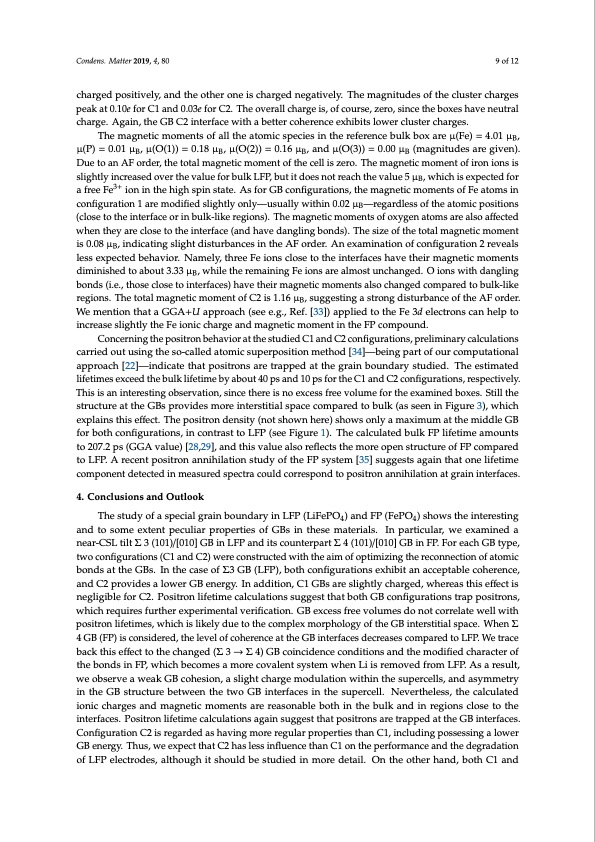
PDF Publication Title:
Text from PDF Page: 009
Condens. Matter 2019, 4, 80 9 of 12 charged positively, and the other one is charged negatively. The magnitudes of the cluster charges peak at 0.10e for C1 and 0.03e for C2. The overall charge is, of course, zero, since the boxes have neutral charge. Again, the GB C2 interface with a better coherence exhibits lower cluster charges. The magnetic moments of all the atomic species in the reference bulk box are μ(Fe) = 4.01 μB, μ(P) = 0.01 μB, μ(O(1)) = 0.18 μB, μ(O(2)) = 0.16 μB, and μ(O(3)) = 0.00 μB (magnitudes are given). Due to an AF order, the total magnetic moment of the cell is zero. The magnetic moment of iron ions is slightly increased over the value for bulk LFP, but it does not reach the value 5 μB, which is expected for a free Fe3+ ion in the high spin state. As for GB configurations, the magnetic moments of Fe atoms in configuration 1 are modified slightly only—usually within 0.02 μB—regardless of the atomic positions (close to the interface or in bulk-like regions). The magnetic moments of oxygen atoms are also affected when they are close to the interface (and have dangling bonds). The size of the total magnetic moment is 0.08 μB, indicating slight disturbances in the AF order. An examination of configuration 2 reveals less expected behavior. Namely, three Fe ions close to the interfaces have their magnetic moments diminished to about 3.33 μB, while the remaining Fe ions are almost unchanged. O ions with dangling bonds (i.e., those close to interfaces) have their magnetic moments also changed compared to bulk-like regions. The total magnetic moment of C2 is 1.16 μB, suggesting a strong disturbance of the AF order. We mention that a GGA+U approach (see e.g., Ref. [33]) applied to the Fe 3d electrons can help to increase slightly the Fe ionic charge and magnetic moment in the FP compound. Concerning the positron behavior at the studied C1 and C2 configurations, preliminary calculations carried out using the so-called atomic superposition method [34]—being part of our computational approach [22]—indicate that positrons are trapped at the grain boundary studied. The estimated lifetimes exceed the bulk lifetime by about 40 ps and 10 ps for the C1 and C2 configurations, respectively. This is an interesting observation, since there is no excess free volume for the examined boxes. Still the structure at the GBs provides more interstitial space compared to bulk (as seen in Figure 3), which explains this effect. The positron density (not shown here) shows only a maximum at the middle GB for both configurations, in contrast to LFP (see Figure 1). The calculated bulk FP lifetime amounts to 207.2 ps (GGA value) [28,29], and this value also reflects the more open structure of FP compared to LFP. A recent positron annihilation study of the FP system [35] suggests again that one lifetime component detected in measured spectra could correspond to positron annihilation at grain interfaces. 4. Conclusions and Outlook The study of a special grain boundary in LFP (LiFePO4) and FP (FePO4) shows the interesting and to some extent peculiar properties of GBs in these materials. In particular, we examined a near-CSL tilt Σ 3 (101)/[010] GB in LFP and its counterpart Σ 4 (101)/[010] GB in FP. For each GB type, two configurations (C1 and C2) were constructed with the aim of optimizing the reconnection of atomic bonds at the GBs. In the case of Σ3 GB (LFP), both configurations exhibit an acceptable coherence, and C2 provides a lower GB energy. In addition, C1 GBs are slightly charged, whereas this effect is negligible for C2. Positron lifetime calculations suggest that both GB configurations trap positrons, which requires further experimental verification. GB excess free volumes do not correlate well with positron lifetimes, which is likely due to the complex morphology of the GB interstitial space. When Σ 4 GB (FP) is considered, the level of coherence at the GB interfaces decreases compared to LFP. We trace back this effect to the changed (Σ 3 → Σ 4) GB coincidence conditions and the modified character of the bonds in FP, which becomes a more covalent system when Li is removed from LFP. As a result, we observe a weak GB cohesion, a slight charge modulation within the supercells, and asymmetry in the GB structure between the two GB interfaces in the supercell. Nevertheless, the calculated ionic charges and magnetic moments are reasonable both in the bulk and in regions close to the interfaces. Positron lifetime calculations again suggest that positrons are trapped at the GB interfaces. Configuration C2 is regarded as having more regular properties than C1, including possessing a lower GB energy. Thus, we expect that C2 has less influence than C1 on the performance and the degradation of LFP electrodes, although it should be studied in more detail. On the other hand, both C1 andPDF Image | First-Principles Grain Boundary Formation in the Cathode Material LiFePO4

PDF Search Title:
First-Principles Grain Boundary Formation in the Cathode Material LiFePO4Original File Name Searched:
condensedmatter-04-00080.pdfDIY PDF Search: Google It | Yahoo | Bing
Sulfur Deposition on Carbon Nanofibers using Supercritical CO2 Sulfur Deposition on Carbon Nanofibers using Supercritical CO2. Gamma sulfur also known as mother of pearl sulfur and nacreous sulfur... More Info
CO2 Organic Rankine Cycle Experimenter Platform The supercritical CO2 phase change system is both a heat pump and organic rankine cycle which can be used for those purposes and as a supercritical extractor for advanced subcritical and supercritical extraction technology. Uses include producing nanoparticles, precious metal CO2 extraction, lithium battery recycling, and other applications... More Info
| CONTACT TEL: 608-238-6001 Email: greg@infinityturbine.com | RSS | AMP |